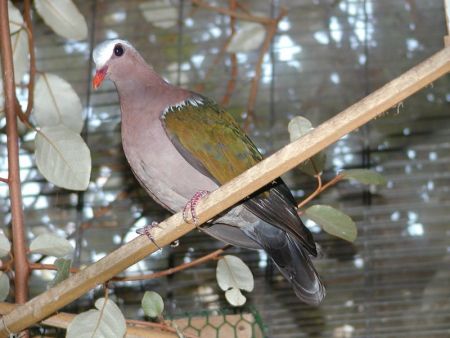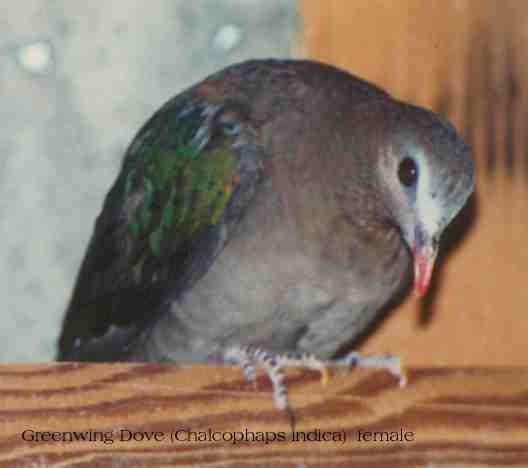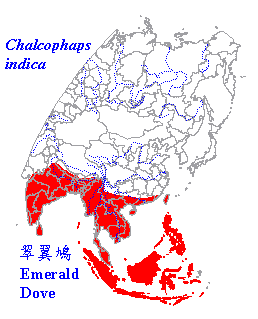
©Jacob Hadomi
Male
Green-winged Dove
Chalcophaps indica
AKA: Emerald Dove, Green-backed Dove, Little Green Pigeon

©Jacob Hadomi
Male

©John Pire
Female


Hatchling
pics ©John Pire
10 days old
Distribution: Found in the both the flat & hilly wooded regions of northern India, Assam & Hainan southward & eastward to the Philippines, New Guinea & eastern Australia.


Races: 8 races recognized; C. i. indica (Linnaeus 1758); C. i. robinsoni (Baker 1928); C. i. maxima (Hartert 1931); C. i. natalis (Lister 1889); C. i. minima (Hartert 1931); C. i. longirostris; C. i. chrysochlora (Wagler 1827); C. i. sandwichensis (Ramsay 1878).
Description: Length 26 cm. Forehead & stripe over & extending behind the eye is white; crown & nape bluish grey; neck & breast maroon suffused with blue grey; mantle wing shields brilliant green, bronze green with coppery red suffusion; white shoulder patch; lower back blackish suffused with copper red or green & having two pale grey bands ; rump & uppertail coverts dark grey; central tail feathers greyish black, outer tail feathers blue grey with broad black subterminal bands with grey tips; iris dark brown; eye cere purplish or reddish purple; bill orange-red, red or yellow with purplish base & cere. Legs & feet purplish red. Female usually more rufous or chestnut on the neck & underparts, whitish forehead is suffused with grey & restricted to front of the forehead & eye stripe (quite variable & may be lacking in some females), crown dark brown; the whitish grey shoulder patch is ill defined or non existent; tail feathers are chestnut with black tips. Juveniles have red brown plumage with blackish bars, no green iridescence. Tail feather dimorphism coloration as in adults (J.Pire 1991).
Nesting: Clutch is two cream eggs; incubation 14 days, young fledge within two weeks.
NOTES: Greenwings can be sexed when fledged, as soon as the
tail feathers grows in on the young birds the color of these tail feathers can distinguish the
bird's sex.
Chestnut tail feathers indicate a hen & dark blue grey tail feathers
indicate a male. There is also a minute plumage difference in the juvenile male
& female Greenwings, it is the width of the "barring" on the chest
areas. Another interesting facet in adult birds: the reversal of the copulation act occurs
several times between the male & female during the courting
ritual.
Tail Feather Dimorphism ![]()
Greenwing Color Mutations ![]() (Blue & Plum Mutants)
(Blue & Plum Mutants)